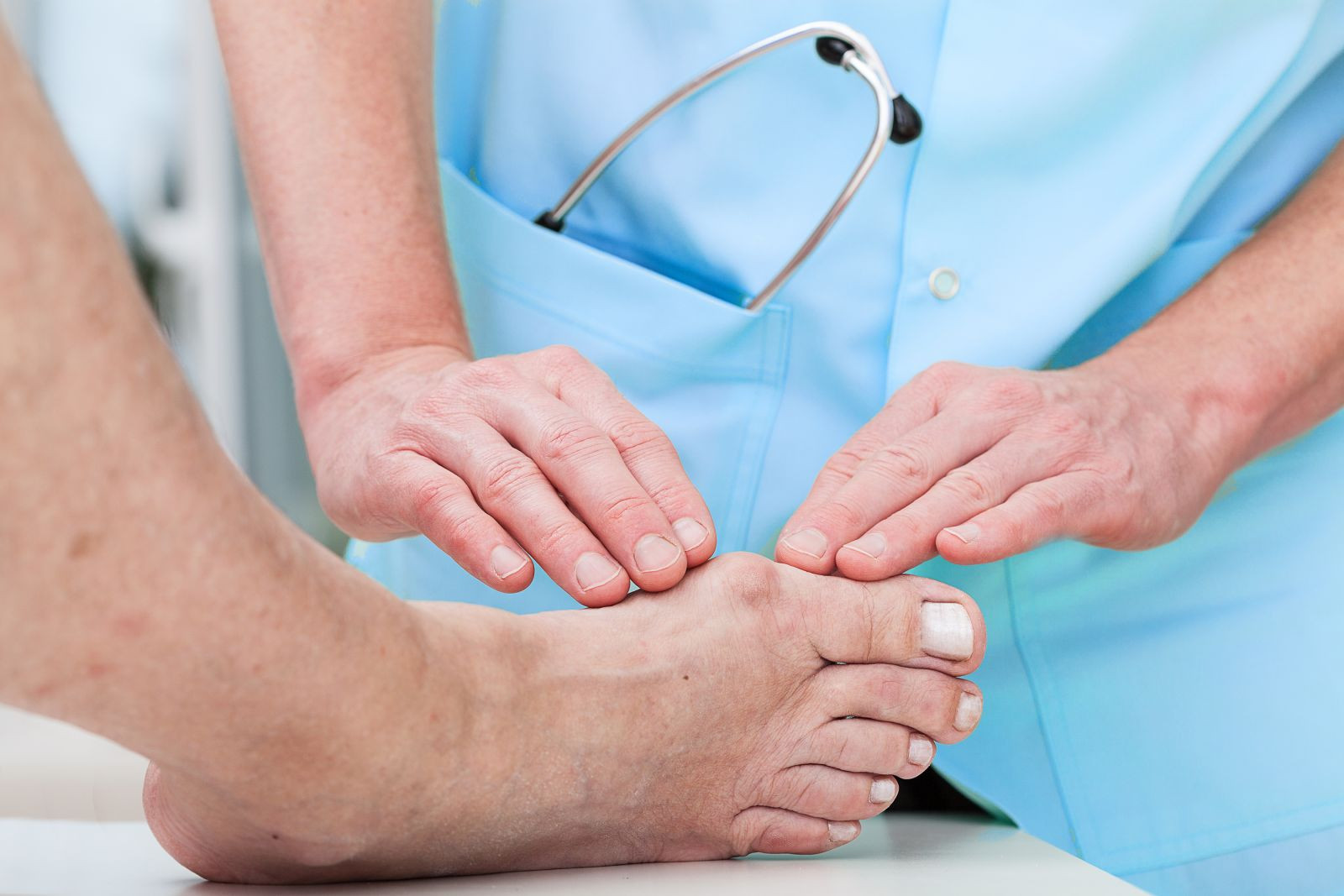Want to treat bunions without surgery? This article covers effective methods to relieve bunion pain and improve foot health without surgery.
Key Takeaways
- Non-surgical treatments, including foot exercises, bunion pads, and proper footwear, are effective method for managing bunion pain.
- Custom orthotics and lifestyle changes, such as regular foot care and avoiding high heels, can help prevent the progression of bunions and maintain foot health.
- Consulting a podiatrist is necessary when experiencing severe pain, difficulty walking, or complications related to bunions to ensure appropriate treatment and management.
Effective Non-Surgical Bunion Treatments
Living with bunions doesn’t mean you have to endure constant pain or rush into bunion surgery. Nonsurgical treatments are often the first line of defense against bunion discomfort and painful bunions. These methods can provide significant relief and help manage the condition without surgery.
Incorporating strategies like bunion splints, anti-inflammatory drugs, and maintaining a healthy weight can effectively reduce bunion pain and improve overall foot health. Here are some of the most effective non surgical bunion treatment available.
Foot Exercises and Stretches
One of the simplest yet most effective ways to alleviate bunion discomfort is through foot exercises and stretches. Regularly engaging in exercises like toe curls and marble pick-ups can help strengthen the muscles around the big toe joint, improving alignment and reducing pain.
Daily toe stretches and massaging the big toe can also provide significant relief at the base of your big toe. Walking barefoot on soft surfaces is another beneficial activity as it helps align bones and strengthen foot muscles, contributing to overall foot health.
Proper Footwear for Bunion Relief
Selecting proper footwear is vital for managing bunion pain and preventing complications. Ill-fitting shoes, particularly those that are tight, narrow, or have high heels, are major contributors to bunion development and discomfort.
Shoes with a wide toe box, low heel, and good arch support can make a significant difference. Brands like New Balance, Nike, and Birkenstock are often recommended for their comfortable and supportive designs.
Here are some specifics on selecting proper footwear.
Choosing Comfortable Shoes with Deep Toe Boxes
Shoes with deep toe boxes are essential to avoid aggravating bunions. These shoes provide ample space for your toes, preventing pressure on the bunion and allowing your feet to align properly.
Comfortable shoes for bunion relief should feature:
- Good cushioning
- Arch support
- A proper fit where shoes don’t slip at the heel
- Enough space for toes to prevent further irritation.
Avoiding High Heels and Pointed Toe Shoes
High heels and pointed toe shoes notoriously exacerbate bunion pain. These types of footwear force your feet into unnatural positions, increasing extra pressure on the bunion and causing discomfort in high heeled shoes.
Avoiding high heels and choosing comfortable, supportive shoes can significantly reduce bunion pain and prevent further damage. Incorporating toe separators and bunion pads can also help minimize friction and irritation.
Custom Orthotics for Extra Support
Custom orthotics are shoe inserts that provide additional foot support. These orthotic devices offer necessary arch support and help alleviate pressure on the big toe joint, significantly reducing bunion discomfort.
Custom orthotics improve foot alignment, ensuring correct positioning during walking and standing, promoting better foot health and reducing pain. This makes them an invaluable tool in managing bunion-related issues.
Bunion Pads and Shoe Inserts
Bunion pads and shoe inserts are crucial for alleviating bunion pain. Bunion pads cushion and support the affected area, relieve pressure and reduce pressure on the affected area, reducing pain. Bunion correctors can also be beneficial in managing this condition.
Shoe inserts provide additional arch support and improve foot alignment, helping to minimize irritation and maintain comfort. These accessories together can significantly manage bunion discomfort and toe spacers.
Ice Packs and Heat Therapy
For immediate pain relief, ice packs and heat therapy can be incredibly effective. Applying an ice pack to the bunion constricts blood vessels, reducing swelling and inflammation. Ice your feet for 15-20 minutes at a time for optimal results.
Heat therapy, such as using heating pads or soaking feet in warm water, improves blood flow and helps relax sore joints and muscles around the bunion. Alternating ice and heat can offer comprehensive relief from bunion pain.
Pain Management Techniques for Bunions
Managing bunion pain effectively requires a combination of strategies. Home remedies, over-the-counter treatments, and professional advice can all play a role in providing relief.
Rest, appropriate footwear, and topical treatments can ease bunion swelling and pain. Here are some specific techniques for managing bunion pain.
Over-the-Counter Pain Relief
Over-the-counter medications are a popular choice for managing bunion pain and can help relieve pain and treat bunion pain. Non-steroidal anti-inflammatory drugs (NSAIDs) like ibuprofen can effectively reduce inflammation and provide bunion pain relief.
However, NSAIDs are not recommended for long-term use in certain individuals. They should be used as part of a broader strategy to alleviate pain management to control pain and avoid potential side effects.
Topical Treatments and Anti-Inflammatory Gels
Topical treatments, such as anti-inflammatory gels, can be directly applied to the bunion to alleviate localized pain. These gels work by reducing inflammation in the affected area, providing quick and effective relief.
Regular application of these bunion treatment options can help manage bunion pain and reduce swelling, making them a valuable addition to your pain management toolkit to treat bunions.
Foot Soaks and Castor Oil Wraps
Foot soaks are a soothing way to manage bunion pain. Soaking your feet in warm water with Epsom salt or Pink Himalayan Sea Salt can provide relief and relaxation.
Castor oil wraps are another effective method. Applying castor oil to a homemade foot wrap and leaving it on overnight can help reduce pain, increase blood circulation, and decrease swelling.
Lifestyle Changes to Prevent Bunion Progression
Lifestyle changes are crucial in preventing the progression of bunions. These include:
- Regular foot soaks
- Choosing low-impact activities
- Taking breaks throughout the day All of these can contribute to better foot health and reduced bunion discomfort.
Addressing root causes and incorporating healthy habits can effectively manage bunion pain and prevent the condition from worsening over time.
Regular Foot Care Routine
A consistent foot care routine is vital for maintaining foot health and preventing any foot condition. Regularly inspecting your feet can help identify early signs of bunion development, allowing for proactive measures.
Moisturizing your feet, using foot files and pumice stones, and wearing protective pads can help alleviate discomfort and prevent bunions from worsening.
Avoiding Prolonged Standing and Walking
Reducing prolonged standing and walking can help alleviate bunion pain. These activities increase pressure on the big toe, aggravating bunions and causing further discomfort.
Taking short breaks throughout the day to rest your feet can significantly manage bunion pain and prevent further complications.
When to Consult a Podiatrist
While non-surgical treatments can be highly effective, there are times when consulting a podiatrist is necessary. Severe pain, swelling, and complications indicate that professional help is needed.
A podiatrist can provide a personalized treatment plan, use imaging to monitor the bunion’s progression, and offer advanced treatments such as cortisone injections or palliative therapy options like electrical stimulation.
Here are specific scenarios where consulting a podiatrist is crucial.
Severe Pain and Swelling
Severe pain and swelling affecting daily activities warrant a consultation with a podiatrist. Ignoring these symptoms, including a painful joint and the affected joint, can worsen the condition and lead to complications requiring more invasive treatments.
Signs indicating the need for medical attention include redness, warmth, and symptoms worse despite home treatments. Seeking professional help can prevent further damage.
Difficulty Walking or Wearing Shoes
Difficulty walking or wearing shoes comfortably is another sign to consult a podiatrist. Properly fitting shoes are essential for managing bunion pain and improving mobility.
If bunion pain significantly impacts walking or wearing shoes, professional advice is essential. A podiatrist can recommend appropriate footwear and treatments to alleviate discomfort.
Developing Complications
When complications such as ulcers or infections arise from bunions, it’s crucial to seek medical advice promptly. A podiatrist can manage developing bunions effectively and prevent further damage.
Summary
Managing bunions effectively without surgery involves a combination of treatments and lifestyle changes. From foot exercises and proper footwear to pain management techniques and regular foot care, there are numerous strategies to alleviate pain and prevent bunion progression. Understanding when to seek professional help is also crucial for long-term foot health.
By incorporating these non-surgical treatments into your daily routine, you can significantly improve your quality of life and keep bunion pain at bay. Take action today and start your journey toward healthier, happier feet.
GET ANSWERS
Frequently Asked Questions
Yes, bunions can often be managed without surgery through methods like foot exercises, proper footwear, bunion pads, and pain management techniques. These approaches can effectively alleviate pain and prevent further worsening of the condition.
For bunion relief, it's best to choose shoes with a wide toe box and good arch support. Brands such as New Balance, Brooks, Hoka and Birkenstock are highly recommended for their suitable designs.
To effectively reduce bunion pain at home, consider using ice packs, heat therapy, foot soaks, and bunion pads, along with over-the-counter pain relief and topical treatments. These methods can provide significant relief and improve your comfort.
You should see a podiatrist for your bunions if you experience severe pain, swelling, or difficulty walking, or if home treatments are not helping. Early professional intervention can prevent complications and improve your mobility.
YES! Custom orthotics are indeed worth it for bunion pain relief, as they offer enhanced support and improve foot alignment, leading to significant reduction in discomfort. Investing in them can be a crucial step in managing your bunion-related pain effectively.




